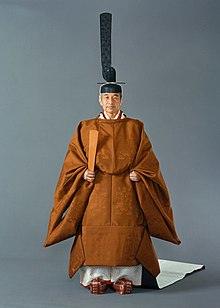
Back فترة هيسي Arabic Oadvezh Heisei Breton Període Heisei Catalan Bìng-sìng CDO سەردەمی ھێیسێی CKB Období Heisei Czech Heisei-Zeit German Hejsej-epoko Esperanto Era Heisei Spanish دوره هیسهای Persian
| Heisei平成 | |||
|---|---|---|---|
| 8 January 1989 – 30 April 2019 | |||
 Emperor Akihito of the Heisei era (1990) | |||
| Location | Japan | ||
| Including | Major events | ||
| Monarch(s) | Akihito | ||
| Key events | |||
Chronology
| |||
| Part of a series on the |
| History of Japan |
|---|
 |
The Heisei era (平成, Japanese: [heːseː] ⓘ) was the period of Japanese history corresponding to the reign of Emperor Emeritus Akihito from 8 January 1989 until his abdication on 30 April 2019. The Heisei era started on 8 January 1989, the day after the death of the Emperor Hirohito, when his son, Akihito, acceded to the throne as the 125th Emperor. In accordance with Japanese customs, Hirohito was posthumously renamed "Emperor Shōwa" on 31 January 1989.
Thus, 1989 corresponds to Shōwa 64 up until 7 January and Heisei 1 (平成元年, Heisei gannen, gannen means "first year") from 8 January. The Heisei era ended on 30 April 2019 (Heisei 31), with the abdication of Akihito from the Chrysanthemum Throne. It was succeeded by the Reiwa era as then-crown prince Naruhito ascended the throne on 1 May midnight local time.[1]
- ^ "Japan's emperor to abdicate on April 30, 2019: gov't source". english.kyodonews.net. Kyodo News. 1 December 2017. Retrieved 1 December 2017.